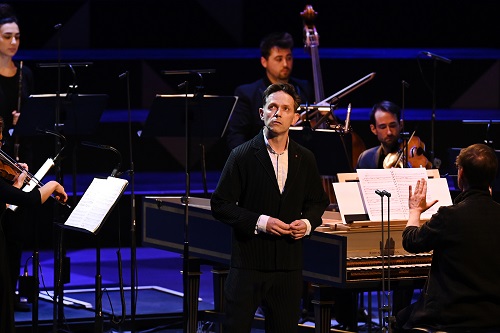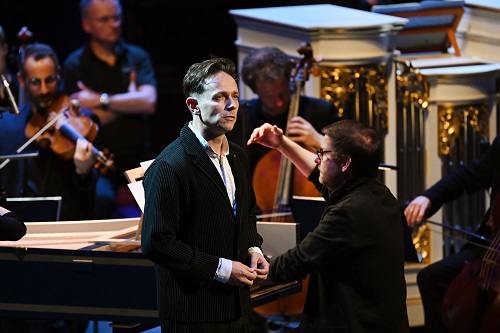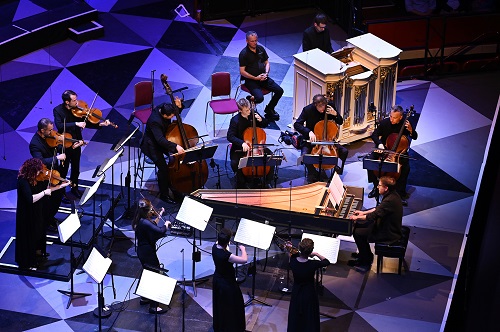In an article in the Daily Telegraph, published just prior to this late-night Prom with The English Concert led by director Kristian Bezuidenhout from the harpsichord, countertenor Iestyn Davies tells us that ‘[t]hroughout his career, Bach’s music was performed in a wide variety of physical locations and his audience could hit about 2,000 to 3,000, either seated in wooden pews, standing or huddled on stairways’. He wants us to think about the way that the two J.S. Bach cantatas – written in 1726, and which Davies has previously recorded on two discs with Jonathan Cohen’s Arcangelo – programmed here, ‘were actually written with huge audiences in mind’ and ‘why Bach’s intimate music is perfect for the Royal Albert Hall’.
Well, there’s been quite a lot of scholarly debate about the performing forces at Bach’s disposal in the churches of St Thomas and St Nicholas in Leipzig, and their technical proficiency. Bach spent the last 27 years of his life as Thomaskantor: 265 cantatas, the St Matthew Passion and the B Minor Mass were written for performance and worship there. It’s a significant musical ‘space’ in terms of the history of Western music. But, I’ve never before encountered the suggestion that audiences of 3000 crammed themselves into the pews.
Indeed, the very theatricality of Bach’s cantatas, perfectly suited as they may be to the vastness and spatial design of the RAH, was in fact counter to terms of Bach’s appointment to St Thomas’s, the minutes of the relevant meeting of the council recording that Bach should ‘der Thomas-Schule seine Treue zu bezeigen’ (‘prove his loyalty to the St Thomas School’) and ‘solche Compositiones zu machen, die nicht theatralisch waren’ (‘make compositions that were not theatrical’). Services were a shared celebration marked by liturgy and sermon, but not the occasion for lengthy cantata performances in a modern operatic style.
But, a little research suggests that Iestyn (I hope he will forgive me the informality) is indeed right – and I take back my doubts! And, this makes the countertenor’s suggestion that ‘there is a parallel to be drawn between Bach’s Leipzig churches and the great rotunda of London’s Royal Albert Hall, with its subscription boxes, varying sight-lines, standing floor space and capacity for several thousands’ more persuasive. The immediacy of opera can, after all, be married, perhaps, with the profundity of Lutheran piety.

Moreover, I don’t doubt for a moment the countertenor’s observation that ‘Bach surely could count on the Prom-goer’s active participation in listening’. This large Proms audience – the Arena was packed – were united in silent raptness. The very theatricality that I’ve noted above, does, paradoxically, make the cantatas perfect for creating the sort of communicative intimacy that is somehow possible at the Royal Albert Hall, despite its vastness, and which on this occasion Iestyn and The English Concert exploited brilliantly and wonderfully.
Bach must have written ‘Vergnügte Ruh, beliebte Seelenlust’ and ‘Geist und Seele wird verwirret’ for one of the young St Thomas’s altos, whose voices didn’t break until they were about seventeen or eighteen, and whom he had the opportunity to mould into exceptional singers. The literary value of the texts (by Georg Christian Lehms) might not be high, but Bach’s musical imagery elevates the words. And, the performers here were alert to the rhetorical power of the give-and-take of argument and counter-argument that Bach structures.
In ‘Vergnügte Ruh’, the hope for heavenly rest in the first aria (mellifluous warmth and textural clarity here from the oboe d’amore and strings), is disrupted by the recitative’s reminder of Satan’s beguiling temptations, which lead to wailing despair in the second aria, though ultimately the will to resist Satan prevails. Singing from memory Iestyn was, as one would expect, entirely alert to the expressive impact of the irregularity of Bach’s phrase structures, and rhymes, and the innate virtuosity of the music – those astonishingly long phrases for example, with seemingly no chance to breathe, were consistently and incisively made to serve the text. In the first aria, there were brief but telling injections of vibrato, to make the import of a single word speak; the recurring motifs were endlessly but subtly reinterpreted to convey the spiritual import of the text; the flowing fluency absolutely conjured the ‘beloved inner joy’ that the text anticipates. Bezuidenhout sometimes pressed his players for a bit more weight and colour, and they responded with a collective spirit.

Iestyn knows how to use a recitative to disrupt an audience’s expectations, or wake them from their complacency – just as Bach had to try to achieve in St Thomas’s, before the sermon proper. And, here he had the potency of a Lutheran preacher, but allied with the vocal beauty of an angelic host. Tom Foster’s organ, with restrained interjections from unison violins and violas, introduced the pained introspection of the second aria, “How those perverted hearts grieve me,/ who have, my God, so offended thee”, the afflictions deepened by Iestyn’s searching melismas and angular melodic forays – so precise and pure, but always coloured with human feeling and frailties. The vigour of the final aria, in which the singer seeks swift admission to heavenly rest, was bracing but measured, and light on its feet.
‘Geist und Seele wird verwirret’ was no less thrilling, from the rich opening ‘Concerto’, with punchy oboe and buoyant celli, that launched, with a purposeful stride, the singer’s appeal to God; through the dignified first aria, in which Iestyn’s dulcet melodising, and floridity, was given piquancy by the nasality of the three oboes (including a taille, or oboe da caccia) and the strings’ pointed articulation and phrasal tautness, as Bezuidenhout balanced rhetoric and restraint. Then, on through the persuasive fluidity of the recitative, to the second aria, a fortifying expression of faith: both Iestyn’s passagework and organist Tom Foster’s fingers flew. The dynamism and string articulation in the Sinfonia which starts the second part of the cantata were arresting – I loved the way the second violins pushed things along from the ‘inside’ of the texture – and Iestyn’s engagement with the instrumentalists in the final aria, which expresses a desire to live with God, was indicative of the countertenor’s discipline, musical intelligence and artistry.

In between the two cantatas we had the third of Bach’s Brandenburg concertos: one to a part, stunningly incisive, amazingly fleet of foot. Gosh, when the second Allegro began, I gasped: surely they couldn’t play it this fast? But, they could. And it was breathless and breakneck and utterly brilliant. I had this crazy image in my head of J.S. Bach seated at the harpsichord and submitting to musical madness, mania and spiritual transfiguration. Not one for the textbook perhaps, but Italianate, dramatic and excitingly evocative of Bach’s revolutionary genius.
This was a late-night Prom to sweep away modern-day anxieties – for a short time, at least – and let one into the uplifting spiritual and musical space carved by Bach’s beliefs – “Gott hat alles wohlgemacht” (God has done all things well) – and his incredible creative boldness.
Claire Seymour
Johann Sebastian Bach: Cantata No.170 ‘Vergnügte Ruh, beliebte Seelenlust’, Brandenburg Concerto No.3 in G major, Cantata No.35 ‘Geist und Seele wird verwirret’
Iestyn Davies (countertenor), The English Concert, Kristian Bezuidenhout (harpsichord/director)
Royal Albert Hall, South Kensington, London; Friday 25th August 2023.
All images (c) BBC / Chris Christodoulou